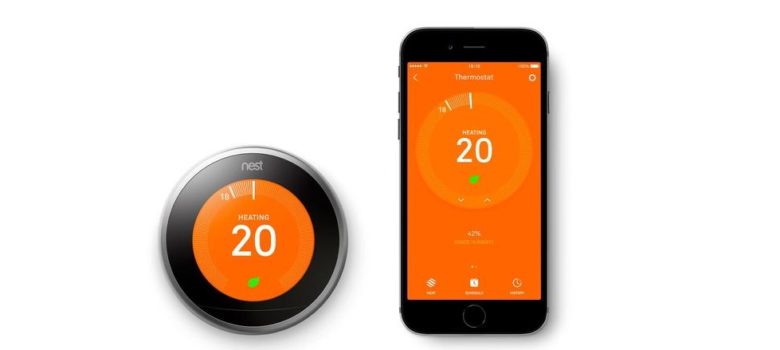
Nest. We’ve all seen the adverts and most of us would recognise the friendly little circular control unit. We’ve even covered some it’s problem before. But what is it like to live in a house with this kind of smart heating, using it every day?
I moved a couple of weeks ago to South West London. A 20’s style semi-detached property with solid walls and gas heating, the property is a pretty good representation of a lot of the homes you’ll see around the outskirts of the capital. Now this house has recently had a lot of work done on it, from new radiators to a brand spanking new extension with underfloor heating. The landlords took the opportunity in the midst of all the work to install, yes you guess it, a Nest thermostat smart home device.
I’ve only been at The Green Age about 6 weeks, so my knowledge of smart home devices is patchy at best. I figured that getting to know this new, clever little alien device might be a good opportunity to explore it’s pros and cons for our readers.
Day 1: Learning to Nest
No one’s been living here since the Nest smart meter was installed, so setup was left to me (that’s fine with me, I’m a bit of a control freak). It took about 5 minutes and was completely painless – all you need your wifi password and access to the Nest hub. With the app installed I was able to pop to the shops for moving-in essentials (bread, milk, 2kg of pasta) and set the heating to come on as I was paying for it all. By the time I got home the radiators were hot and the house was warming up.
The other nice thing about setup is that you’re not limited to one control account, so while I signed in with my own email on my phone, my housemate had the option to use her own email to set up a separate account on her own devices. They’re all free and you can connect multiple hubs to the same account – so if you’ve got a Nest at home but there’s also one at your mums, you can control them both from the same application. This is a simple things, but definitely made my housemate and I feel like the system had been well considered from an end-user perspective.
Day 3: Loving Nest!
Cool function alert! The app on my phone asked me if I wanted it to link up with the hub to track when I’m home using my phone’s location. This helps the smart tech learn my routine – when I’m likely to be home, when I’m likely to be at work, and how warm I like the house kept in either situation. Although I was slightly concerned about privacy – I get a bit antsy about anything that tracks my movements – I’ve turned it on to see how it’ll work out. My housemate has yet to download the app and register for an account, so I’m curious to see how it will react when she does – if it learns only my routine what will it do when a second person is suddenly introduced? If it doesn’t quite work out then we can always set up a schedule manually.
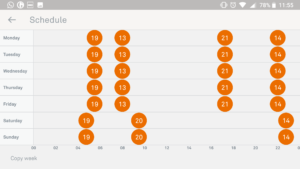
Day 10: Limitations of Nest
My god, the ice age has made its return in South London! It’s been so cold, especially considering it’s February. The impressive bruise on my bottom from slipping on the ice this morning is living proof. Luckily for me, my nest has already learned a lot about my schedule and anticipated me coming home by turning on the heating. Walking through the door, pink nosed and aching with the cold I was pretty delighted to get a rush of warm air.
I say warm and not hot because I’ve been making the most of one of Nest’s best functions, in my opinion. Nest has not only an ECO button, but also indicates whether the temperature you’ve set is within it’s ECO range. This means that you are constantly aware of how ecological, not to mention economical, your heating practices are. It’s a built in feature so there’s no ignoring it, which is a good thing for those of us that are forgetful or prone to wacking up the heating without thought. For this reason, I think the ECO indicator feature will be saving our household a decent chunk of change.
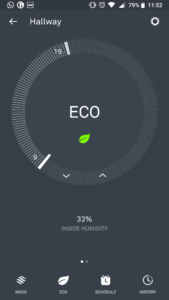 I have come across a problem though. As I mentioned, before I moved into this house a lot of work was done. Almost all of this went on downstairs while the upstairs has remained relatively untouched, but with large rooms and old radiators, this means the upstairs can unfortunately get really chilly. The Nest hub is located downstairs, near a brand new radiator and above the underfloor heating; it’s in one of the warmest parts of the house. Therefore, if I set the Nest to a certain temperature, it will automatically stop heating the house as soon as it’s thermostat sensor announces that it’s been achieved, even if the rest of the house is still freezing.
I have come across a problem though. As I mentioned, before I moved into this house a lot of work was done. Almost all of this went on downstairs while the upstairs has remained relatively untouched, but with large rooms and old radiators, this means the upstairs can unfortunately get really chilly. The Nest hub is located downstairs, near a brand new radiator and above the underfloor heating; it’s in one of the warmest parts of the house. Therefore, if I set the Nest to a certain temperature, it will automatically stop heating the house as soon as it’s thermostat sensor announces that it’s been achieved, even if the rest of the house is still freezing.
Now obviously this is a design floor in both the positioning of the hub and of the renovations made on the house, but it does draw attention to a bigger trend in home heating. Millions of us rely on single thermostat central heating, despite this exact issue of different temperatures in different parts of the house, but slowly and surely we’re moving away from that system due to its inefficiency. More and more people are preferring to create different heating zones and control each room/area separately. While this is theoretically possible with Nest, it involves multiple hubs and multiple Heat Links, adding up to significant additional costs, not to mention installation work. Nest is designed as a single zone system, and for some people this fact will make the tech seem outdated and unsuitable.
Day 28: Living with Nest
I’ve been living in the new place with the new smart heating system for nearly a month now and I think we’ve got a pretty happy relationship. Everyone in the office is wildly jealous that I can make sure I haven’t left the heating on all day, or set it to turn on before I leave for home. I still have the problem of the upstairs being colder than the Nest hub is clever enough to realise, but I picked up some Radflek using the exclusive GreenAge offer code TGA20 for 20% discount, and that’s definitely improved the performance of the older radiators. This weekends project is to properly bleed them and perhaps invest in some EndoTherm, which should enhance their heating capabilities and help close the difference in temperature between upstairs and downstairs.
Watch this space – I’m going to keep an eye on our heating bills and report back as to whether or not we’re really saving money. I have to say though, I’d be extremely surprised if we’re not. Despite the limitations, this Green Ager is a certified Nest convert.
Think we missed something? Do you have a different opinion?
Comment below to get your voice heard…
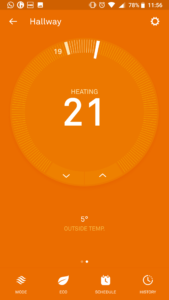






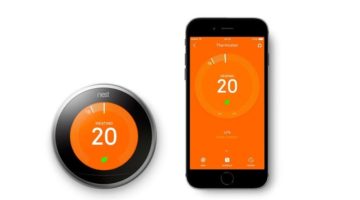





Interesting report. I dont expect their is a huge amount RedFlek and EndoTherm can do to even out the unbalanced radiator placement. With these things, in the main, I guess it depends if you have a regular routine like a 9-5 job which a simple timer could do fine, or come and go more randomly.